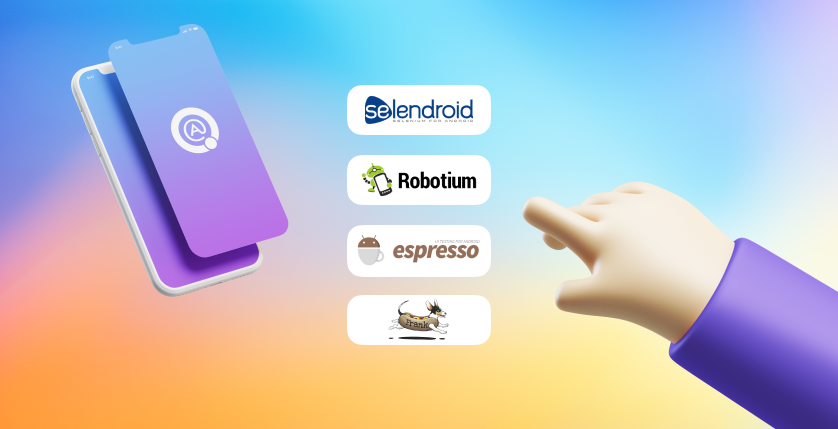The mobile app market is rapidly evolving. Currently, applications encompass all types, from various calculators to mobile games and banking apps. However, mobile app testing is a rather complex process that involves many individual features. Therefore, it is challenging to single out just a few tools for mobile testing because each specific app or team may require its own program. To address this, the mobile testing system market was studied and analyzed, identifying the most effective tools based on various indicators. The most interesting tools, in our opinion, have been collected in a series of articles (links to the first and second parts).
Mobile testing tools (Part 3)
- 03.10.2023
- Posted by: Admin

Testsigma
![]() Testsigma is an open-source, AI-driven automation testing tool for iOS and Android. This program helps evaluate usability, sequence, and compatibility of applications in the current development scenario. Its extensive functionality allows you to avoid using multiple tools and cover many tasks with just one product. The intuitive interface accelerates and simplifies work. Testsigma allows you to create artifacts such as test types, test priorities, and requirement categories. You can run tests in parallel, group and execute them on different operating systems, devices, and browsers to significantly reduce testing time.
Testsigma is an open-source, AI-driven automation testing tool for iOS and Android. This program helps evaluate usability, sequence, and compatibility of applications in the current development scenario. Its extensive functionality allows you to avoid using multiple tools and cover many tasks with just one product. The intuitive interface accelerates and simplifies work. Testsigma allows you to create artifacts such as test types, test priorities, and requirement categories. You can run tests in parallel, group and execute them on different operating systems, devices, and browsers to significantly reduce testing time.
Key features:
- working with Testsigma locally or in the cloud;
- artificial intelligence automatically corrects broken scenarios, restores dynamically changing elements, and suggests fixes for testing errors;
- creating test scenarios in English. The intelligent test recorder automatically transforms user actions into editable steps;
- stable and reliable automated tests without complex configurations, integrations, or development efforts;
- cross-browser testing for websites, mobile apps, and APIs;
- minimal test and framework maintenance;
- tests on a local browser/device or launching tests on over 800 browsers and more than 2000 devices in a cloud-based test lab;
- built-in test data management for parameterized testing;
- full integration with CI/CD, error reporting, product management tools, collaboration tools, and test labs for continuous testing;
- 100+ ready-made add-ons (for special actions, data generators, integrations) or create your own ones using Testsigma SDK;
Pricing: The tool is free with basic options, and there are paid packages available for larger teams and companies.
BitBar
 BitBar is a flexible mobile app testing tool that works on any framework and device. It offers an efficient cloud of mobile devices, containing over 200 real models of iOS and Android devices. BitBar stands out from other tools with zero configuration, maximum parallel testing, stable and fast monitoring tests. You can easily set up mobile testing and development environments, speed up deployment, and evaluate the latest technologies.
BitBar is a flexible mobile app testing tool that works on any framework and device. It offers an efficient cloud of mobile devices, containing over 200 real models of iOS and Android devices. BitBar stands out from other tools with zero configuration, maximum parallel testing, stable and fast monitoring tests. You can easily set up mobile testing and development environments, speed up deployment, and evaluate the latest technologies.
Key features:
- quick migration of virtual machine-based or Docker-based frameworks;
- local and cloud-based mobile device testing;
- remote device management using gestures for issue resolution, exploratory testing, and debugging;
- access to devices through SSH/VPN tunneling;
- Single Sign-On (SSO) authentication management;
- many other operations such as device connection resets, performance monitoring, test prioritization, and device cleaning scheduling. All these features are available on the admin dashboard with queue visibility.
Pricing: This tool is paid, but you can get a free 14-day trial version.
Digital.ai
 Continuous testing by Digital.ai allows companies to conduct large-scale testing, increase testing coverage, and make data-driven decisions to create high-quality error-free web and mobile applications.
Continuous testing by Digital.ai allows companies to conduct large-scale testing, increase testing coverage, and make data-driven decisions to create high-quality error-free web and mobile applications.
Key features:
- testing of both functional scenarios and performance-related scenarios, scaling projects according to increasing release requirements;
- extensive and secure testing on a large matrix of real devices and browsers located in Digital.ai's ISO 27001 and SOC-2 compliant secure global data processing centers;
- automation of mobile and cross-browser testing on a single platform;
- reliable and stable test scenarios with advanced identification methods and a new test editor;
- integration with existing development tools, IDEs, testing platforms, and CI environments;
- obtaining comprehensive information about quality and achieving improvements through the Integrate and Test Lens;
- performance analysis through server simulation, transaction measurement, and speed index measurement;
- testing of voice control and gestures to ensure accessibility of websites and applications for people with disabilities;
- test project management with remote access, progress tracking, and usage reporting;
- automatic test generation for functionality and rapid test creation without programming skills.
Pricing: The tool is paid, there is a free trial version available upon registration.
Flutter
![]() Another tool developed by Google for creating mobile (iOS and Android), web, and desktop products. It allows for the creation, testing, and deployment of applications from a single codebase.
Another tool developed by Google for creating mobile (iOS and Android), web, and desktop products. It allows for the creation, testing, and deployment of applications from a single codebase.
Key features:
- easy code modification and updating on emulators, simulators, or real devices;
- reviewing real-time results using Hot Reload;
- background caching through service workers;
- reliable null safety to reduce null reference exceptions;
- supported and used by Google and the global developer community.
Pricing: Open source.
Some tools are designed for testing on only one operating system. Further on, the following narrowly focused programs will be considered.
Selendroid
 Selendroid is an open-source test automation platform designed for native and hybrid Android applications. Like the Selenium framework, Selendroid's capabilities can be utilized for parallel testing on emulators, simulators, and real devices.
Selendroid is an open-source test automation platform designed for native and hybrid Android applications. Like the Selenium framework, Selendroid's capabilities can be utilized for parallel testing on emulators, simulators, and real devices.
Key features of Selendroid:
- full compatibility with the JSON wire protocol;
- ability to interact with multiple Android devices simultaneously;
- testing mobile Internet using built-in web browser drivers for Android;
- gesture support;
- seamless integration as a node in the Selenium Grid for scalability and parallel testing;
- allows checking the current state of the application's user interface;
- built-in inspector to simplify test development;
- support for multiple target Android APIs.
Pricing: The tool is free.
Robotium
 Robotium is one of the leading and free frameworks for automated testing of Android applications. It can be a valuable part of any testing toolkit. This user-friendly tool supports Android versions 1.6 and higher. Robotium is a library for modular testing. Even with minimal project knowledge, you can create powerful test cases. The tests are written in Java, and support testing both native and hybrid applications. Robotium has found extensive use in black-box automated testing.
Robotium is one of the leading and free frameworks for automated testing of Android applications. It can be a valuable part of any testing toolkit. This user-friendly tool supports Android versions 1.6 and higher. Robotium is a library for modular testing. Even with minimal project knowledge, you can create powerful test cases. The tests are written in Java, and support testing both native and hybrid applications. Robotium has found extensive use in black-box automated testing.
Key features:
- ability to handle multiple Android actions simultaneously;
- powerful test scenarios can be created quickly with minimal project knowledge;
- synchronization with Ant or Maven for running tests as part of continuous integration;
- suitable for open-source projects or APK files;
- automatic synchronization;
- ability to run test cases on pre-installed applications.
Pricing: An open-source and free tool.
UI Automator
 UI Automator is an open-source platform that allows testing the user interface through automated functional tests. The tool provides a set of APIs for interacting with user and system applications. UI Automator is well-suited for writing black-box-style automated test scenarios where the test code does not require access to the application's code.
UI Automator is an open-source platform that allows testing the user interface through automated functional tests. The tool provides a set of APIs for interacting with user and system applications. UI Automator is well-suited for writing black-box-style automated test scenarios where the test code does not require access to the application's code.
Advantages:
- ability to run the program on one or multiple devices;
- the framework uses scenarios written in JavaScript;
- has an API file containing class interfaces and exceptions;
- simple and easy to learn;
- includes a layout hierarchy viewer - UI Automator Viewer;
- the library is supported by the Google community.
Pricing: A free and open-source tool, with available third-party paid integration with cloud test management tools.
Espresso
 Espresso is an automated testing framework for Android developed by Google. It's a simple, efficient, and flexible system. One of Espresso's key features is its ability to automatically synchronize test actions with the user interface of the application. The framework also ensures that actions are initiated before the test is launched. It can also make the test wait until all background observer actions are completed, which can sometimes be a problem with other testing platforms. With Espresso, you can create tests closely aligned with the logic of Android applications.
Espresso is an automated testing framework for Android developed by Google. It's a simple, efficient, and flexible system. One of Espresso's key features is its ability to automatically synchronize test actions with the user interface of the application. The framework also ensures that actions are initiated before the test is launched. It can also make the test wait until all background observer actions are completed, which can sometimes be a problem with other testing platforms. With Espresso, you can create tests closely aligned with the logic of Android applications.
Key features:
- support for Java and JUnit for native applications;
- lightweight APIs to simplify maintenance;
- automatic synchronization of user interface elements and testing actions;
- ability to compile Android interface tests into APKs;
- suitable for writing black-box tests;
- part of the Android Support Repository;
- simple and easy to set up.
Pricing: Espresso is a free, open-source system.
Frank
 Frank is an open-source platform for testing iOS that combines the functionalities of Cucumber and JSON. It is one of the best lightweight automation tools available. Using a clean CSS-like selector syntax, Frank allows for relatively permissive testing.
Frank is an open-source platform for testing iOS that combines the functionalities of Cucumber and JSON. It is one of the best lightweight automation tools available. Using a clean CSS-like selector syntax, Frank allows for relatively permissive testing.
Key features:
- helps write structured acceptance tests and requirements;
- includes the Symbiote app inspector;
- no need to modify the application code;
- test scenarios are written in English sentences using the Cucumber framework;
- easy configuration.
Pricing: Frank is an open-source platform and completely free to use.
iOS Driver (iOS)
 This is an open-source tool capable of seamless integration with the Selenium network and automating native and hybrid iOS applications using the Selenium/WebDriver API. The program operates more efficiently on emulators rather than on actual devices. Some of the latest versions work on devices as well, but they are somewhat slower than on emulators.
This is an open-source tool capable of seamless integration with the Selenium network and automating native and hybrid iOS applications using the Selenium/WebDriver API. The program operates more efficiently on emulators rather than on actual devices. Some of the latest versions work on devices as well, but they are somewhat slower than on emulators.
Key features:
- automation of testing for native and hybrid applications using Selenium or WebDriver API;
- no need to modify any application code or install additional programs to test the app on a device;
- efficient operation in emulators;
- compatibility with selective Apple X-code features after setup;
- can be used as a Selenium Grid Node, reducing feedback time for GUI testing.
Pricing: A free, open-source platform.
EarlGrey
 EarlGrey is an automated testing platform for native iOS applications. It is developed and maintained by Google. This framework is also used within Google for functional testing of native iOS apps such as YouTube, Google Calendar, Google Photos, Google Translate, and others. It provides QA teams with access to advanced synchronization features for stable user interface testing.
EarlGrey is an automated testing platform for native iOS applications. It is developed and maintained by Google. This framework is also used within Google for functional testing of native iOS apps such as YouTube, Google Calendar, Google Photos, Google Translate, and others. It provides QA teams with access to advanced synchronization features for stable user interface testing.
Key features:
- synchronization that allows test scenarios to wait for specific user interface events before interacting with the app's UI;
- manual insertion of custom timings;
- white-box testing methodology;
- native development tests can be run directly from Xcode or xcodebuild.
Pricing: EarlGrey is an open-source mobile testing platform and is free to use.
XC Test
 XCUI Test is an Apple product for iOS developers to create scenarios and run user interface tests using the Xcode IDE. The XCUI Test framework is considered one of the best for testing mobile applications that are easy to maintain, avoid testing instability, and enhance the overall continuous integration process.
XCUI Test is an Apple product for iOS developers to create scenarios and run user interface tests using the Xcode IDE. The XCUI Test framework is considered one of the best for testing mobile applications that are easy to maintain, avoid testing instability, and enhance the overall continuous integration process.
Key features:
- available scripting languages: Swift and Objective-C;
- integration with Xcode, third-party tools, and frameworks for test recording;
- Xcode integration to simplify coding through methods, subclasses, or assertions;
- support for CI/CD integration;
- suitable for black-box testing;
- tests can measure the performance of code blocks to check for performance regressions;
- interaction flow validation.
Pricing: XCUI Test is an open-source and free tool.
We have reviewed the best mobile app testing tools along with their features and pricing. Some of the mentioned testing tools have open-source code and can be downloaded for free, while others require a subscription. Each of the testing programs mentioned above has unique characteristics and features. Of course, none of these tools are perfect. When choosing the right system (or several), factors to consider include availability, compatibility, network configuration, system configuration, and more. Effective testing can be achieved by using tools that align with selection criteria and budget constraints.


